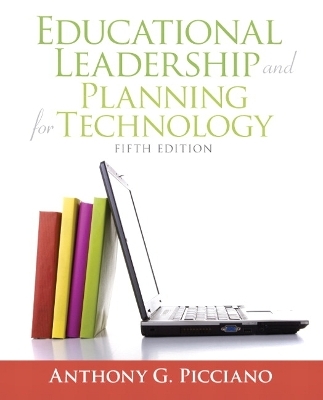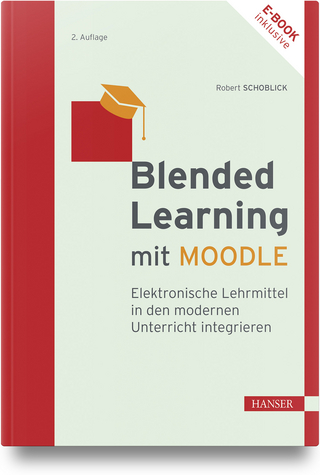
Educational Leadership and Planning for Technology
Pearson (Verlag)
978-0-13-705822-8 (ISBN)
The newly revised fifth edition of Educational Leadership and Planning for Technology provides educators with both the theoretical and the practical considerations for planning and implementing technology in today’s schools, with an emphasis on the total application of technology including both administrative and instructional uses. Designed for preservice and inservice educators such as administrators, teachers, technology coordinators, and media specialists, this fifth edition text builds a strong foundation from which educators may provide informed leadership and become agents for realizing the powerful potential of technology in their schools.
"I have used the textbook in teaching my course, Leadership in Educational Technology, in an online format the past four springs. I began the course and found this text to be the best available. I am still of that opinion." --Patrick Durow, Creighton University
"I have used this text primarily because of it's accessible writing and it's completeness of coverage. I do not use many texts in my teaching, so it is a compliment to any author when I can use their work in my courses." --Steven Smith, Northern Kentucky University
Anthony G. Picciano is the author of nine books in the fields of educational leadership, technology, and research methods, including Blended Learning: Research Perspectives (Sloan Consortium, 2007) and the Educational Research Primer (Continuum, 2004). Picciano is a professor in the Education Administration and Supervision Program in the School of Education at Hunter College. He is also a member of the faculty in the Ph.D. Program in Urban Education, the doctoral program in Interactive Pedagogy and Technology, and the CUNY Online BA Program in Communication and Culture at the City University of New York Graduate Center. His teaching specialties include educational technology, organization theory, policy, and research methods.
SECTION I Basic Concepts and Foundations
1 Introduction to Technology and Planning
Purpose
The Potential in Primary and Secondary Schools
The Beginning Years
Steady Progress in Administrative Systems
Instructional Systems Show Promise
The Need for Planning
The Systems Approach
Organization
Summary
Key Concepts and Questions
Suggested Activities
References
2 Basic Concepts of Planning
Planning Fundamentals
Schools as Social Systems
Evaluating the Bottom Line: The Social Process and Rational Models
Common Elements of Educational Planning
Comprehensiveness
Collaboration
Commitment
Continuity
Planning for Technology
Taking a Positive Attitude to Evaluation
Administrative and Instructional Applications
Planning for Administrative Applications
Planning for Instructional Applications
Case Study
Summary
Key Concepts and Questions
Suggested Activities
References
3 Technology, Learning, and Equity Issues
Technocentric Education
When Should Computer Education Begin?
Special Education
Gender Issues
Digital Divide Issues
Case Study
Summary
Key Concepts and Questions
Suggested Activities
References
SECTION II Technology in Action
4 Technology for School Leadership
Knowledge Is Power
The Age of Knowledge
Databases
Electronic Spreadsheets
Office Automation
Specialized Administrative Applications
Integrating It All Together: Data-Driven Decision Making
Case Study
Summary
Key Concepts and Questions
Suggested Activities
References
5 Wisdom and Data-Driven Decision Making
Defining Data-Driven Decision Making
Information Infrastructure
Hardware for Effective Data Management and Access
Software for Data Management and Analysis
People, Decision Making, and the
Social Nature of Information
The Data Analyst Data-Driven Decision Making Applications
School Enrollment Projections
Improving Teaching and Learning
The Anatomy of a Survey
Evaluation and Nurturing the Process
Summary
Key Concepts and Questions
Suggested Activities
References
6. Technology in Instruction
Instructional Computing: A New Beginning
Instructional Computing: Some History
A Brief Review of the Research
Defining Technology’s Role: A Touch of Philosophy
Classification Systems and Definitions of Terms
Instructional Software Tools
Instructional
Basic Technology Tools
Word Processing and Desktop Publishing
Spreadsheets
Databases
Electronic Encyclopedias and Reference Works
Specialized Tools and Probeware
Electronic Textbooks (EBooks)
Learning Tools
Drill and Practice
Tutorials
Simulations
Instructional Gaming, Problem Solvingand MUVEs
Programming and Authoring Tools
Programs
High-Level Programming Languages
Authoring Languages
Integrated Learning Systems
Multimedia: A Brief Word
Data Communications
Curriculum Integration and Planning
Case Study
Summary
Key Concepts and Questions
Suggested Activities
References
7 Multimedia in Education
Multimedia Defined
Multimedia for Multiple Intelligences
Multimedia Literacy
Multimedia Technology
Five Levels of Digital Media
The Evolution of Video Technology
Videocassette
Analog Videodisc Technology
Digital Versatile Disc Technology
Multimedia Software
Authoring
Image, Video, and Sound Editing
Digital Animation
Multimedia for Teaching and Learning
Multimedia Resources and Copyrights
Media Distribution Systems - Whiteboards
Case Study
Summary
Key Concepts and Questions
Suggested Activities
References
8 Data Communications, the Internet, and Educational Applications
Data Communications in the Schools
The Internet
A Brief History
The Internet Today
The Future of the Internet
The World Wide Web
Protocols and Client Servers
Uniform Resource Locator (URL)
Web Browsers and Search Engines
Commercial Online Services
Applications on the Internet
Multimedia and the Web
Designing Multimedia for Web-Based Learning
Desktop Videoconferencing
The Internet and Education
Global E-Mail
Information Navigation
Creating Web Sites
Blogging on the Web
Course Management Software (CMS)
The Internet and Distance Learning
Summary
Key Concepts and Questions
Suggested Activities
References
9 Distance Learning
Distance Learning Defined
Distance Learning Technologies: An Overview
Blended Learning
The Extent of Distance Learning in K-12 Education
Designing Instructional Materials: A Comparison of Distance Learning Technologies
The Interactive Videoconference
Asynchronous Learning Using the Internet and World Wide Web
Blended Learning Course
Distance Learning Providers
Distance Learning: Some Issues
The Future of K-12 Distance Learning
Case Study
Summary
Key Concepts and Questions
Suggested Activities
References
SECTION III Planning and Implementation
10 Hardware and Software Evaluation
Decisions, Decisions, Decisions
A Look at Hardware
A Look at Software
Hardware Evaluation Criteria
Performance
Compatibility
Modularity/Expandability
Ergonomics
Software Availability
Vendor
Cost
Software Evaluation Criteria
Efficiency
Ease of Use
Documentation
Hardware Requirements
Vendor
Cost
Issues in Evaluating Hardware
Evaluating Hardware for Administrative Applications
Evaluating Hardware for Instructional Applications
Mainframes and Servers
Bulk Purchasing, State Contracts and Life Cycles
Issues in Evaluating Software
Administrative Software Evaluation
Instructional Software Evaluation
Open Source Software
Software Life Cycles
Case Study
Summary
Key Concepts and Questions
Suggested Activities
References
11 People, Technology and Professional Development
A Long Way to Go
The Professional Development Planning Model
Who Learns?
Different Alternatives for Different Needs
Designing and Implementing Effective Staff Development Programs
Hands-On Activities
One-on-One Coaching
Training the Trainer
Teachers Need Equipment, Too!
Incentives
Evaluation and Review
A Continuous Process
Resources
Case Study
Summary
Key Concepts and Questions
Suggested Activities
References
12 Facilities, Policies and Procedures
Getting Bigger
Staffing and Administration
Central Laboratories
Physical Environment
Facilities for Administrative Applications
Facilities for Instructional Applications
Data Communications Facilities and Information Infrastructur
Hardware Maintenance
Making Repairs
Providing Preventive Maintenance
Upgrading
Software Maintenance and Distribution
Policies, Procedures, and Documentation
Policies Procedures
Documentation
Security
The Helping Place
Case Study
Summary
Key Concepts and Questions
Suggested Activities
References
13 Financial Planning
Technology Can Be Expensive
The Cost-Effectiveness of Technology
A Time Line for Financial Planning
The Budget Worksheet
A Budget Modeland Total Cost of Ownership
Special Considerations of Budgeting for Computer Applications
Opting for Centralized or Decentralized Computer Facilities
Hiring a Consultant
Standardizing on a Common Vendor
Hardware First, Other Needs Later?
Choosing a Purchasing Plan
Sources of Funds
The School District Budget
Bond Issues
Governmental Entities
Gifts and Grants
Case Study
Summary
Key Concepts and Questions
Suggested Activities
References
Epilogue
Appendix A Basic Concepts of Computer Technology
Appendix B Educational Leader Competencies
Appendix C Instructional Software Evaluation Factors
Glossary
Index
| Sprache | englisch |
|---|---|
| Maße | 100 x 100 mm |
| Gewicht | 100 g |
| Themenwelt | Schulbuch / Wörterbuch ► Unterrichtsvorbereitung ► Unterrichts-Handreichungen |
| Sozialwissenschaften ► Pädagogik ► Berufspädagogik | |
| Wirtschaft ► Betriebswirtschaft / Management ► Finanzierung | |
| Wirtschaft ► Betriebswirtschaft / Management ► Personalwesen | |
| ISBN-10 | 0-13-705822-5 / 0137058225 |
| ISBN-13 | 978-0-13-705822-8 / 9780137058228 |
| Zustand | Neuware |
| Haben Sie eine Frage zum Produkt? |
aus dem Bereich


